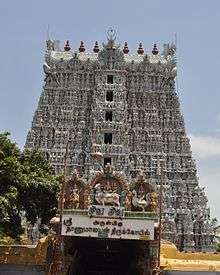Thanumalayan Temple
Coordinates: 8°09′17″N 77°27′54″E / 8.1548°N 77.4651°E

The Thanumalayan Temple, also called Sthanumalayan Temple is an important Hindu temple located in Suchindram in the Kanyakumari district of Tamil Nadu, India.
The Thanumalayan Temple is of importance to both Shaivaite and Vaishnavite sects of Hinduism, as the name Stanumalaya denotes Trimurtis; "Stanu" means Siva; "Mal" means Vishnu; and the "Aya" means Brahma.[1]
History
The current temple was built in the 17th century and is famous for its sculptures. It was previously controlled by the Nambudiris, one of the main Namboodiri families called the Thekkumon Madam. The main deity of the temple is Lord Shiva, Lord Vishnu and Lord Brahma in a single form called Sthanumalyam.[2] This 17th-century temple is famous for its architectural grandeur. The seven-storey white Gopuram is visible from the distance. Its 40 m facade is covered with sculptures of Hindu deities.[3]
The place got the name of Suchindrum from the Sthala Purana. Hindu mythological legend has it that king of devas, Indra got relieved of a curse at the place of the main linga in the temple. The term "Suchi" in Suchindrum is believed to have derived from the Sanskrit meaning that stands for "purify". Accordingly, Lord Indra is supposed to visit the temple for performing "Ardhajama Pooja", or worship, at midnight every day.
Thirumalai Nayak and the Travancore Maharajas, under whose administration the temple remained till Kanyakumari's merger with Tamil Nadu, have made many endowments for its upkeep. It is interesting to note that during the reign of Ayilyam Thirunaall Maharajah of Travancore, a lottery scheme was introduced in 1875 A.D., to raise funds for rebuilding a portion of the temple and a sum of over Rs. 40,000 was realised.[4]
Description
The temple is an architectural achievement, known for its quality of workmanship in stone. There are four musical pillars carved out of a single stone, and which stand at 18 feet (5.5 m) in height; these are an architectural and design highlight of the temple grounds. They are in the Alankara Mandapam area, and they emit the sounds of various musical notes when struck. There are an additional 1035 pillars with carvings in the area known as the dancing hall.[5]
There is an Anjaneya, (or Hanuman), statue which stands at 22 feet (6.7 m) and is carved of a single granite block. It is one of the tallest statues of its type in India. It is also of historical interest that this statue was buried in the temple in 1740, fearing an attack by the Tipu Sultan and was subsequently forgotten. It was rediscovered in 1930, and subsequently restored for viewing by the then Devaswom Board Commissioner Rajya Seva Praveena Sri M.K. Neelankantha Iyer of Kottarathu Mathom, Moncompu.[6]
There is also a Nandi statue, made of mortar and lime, which is 13 feet (4.0 m) tall and 21 feet (6.4 m) long, it is one of the biggest Nandi statues in India.
The religious significance of the temple stems from the fact that the main statue of linga represent Siva (Sthanu), Vishnu (maal) and Brahma (Ayan), (as well as giving the temple its name). The representation of the three central gods of Hinduism in one linga makes it unique in India. Anthropologically it may have stemmed from the fact that the main temple at Padmanabhapuram was Vaishnavite, and the Nanjil Pillais and other communities in Nagarcoil were primarily Shaivaites, because of the influences from Chola, Chera and Pandya kingdoms. One of the unique aspects of the temple is the presence of the gods across the length and breadth of the Hindu pantheon, from Rama and Krishna to Amman and kandan. The different Hindu sects from Vaishnavism, Shaivism, to more localised Tamil sects like amman, kandan are represented in the different idols of the temple.
The 10-day Car Festival celebrated in this temple during between December and January every year attracts crowds of thousands of people. Another festival known as Teppam is celebrated during between April and May every year. The Sanskrit work Sucindrastalamahatmya gives a full-fledged legendary account of the origin and development of this temple.


References
- ↑ THE HINDU. The Hindu http://www.thehindu.com/br/2002/01/29/stories/2002012900150300.htm. Retrieved 2016-07-30.
|first1=missing|last1=in Authors list (help); Missing or empty|title=(help) - ↑ http://www.indiastudychannel.com/resources/156292-Tourist-attractions-Kanyakumari-district.aspx Suchindrum Temple Notes
- ↑ http://aarathi78.canalblog.com/archives/2011/10/19/22403007.html Architectural Grandeur
- ↑ http://www.thehindu.com/br/2002/01/29/stories/2002012900150300.htm
- ↑ "The Sampradaya Sun — Independent Vaisnava News — Feature Stories — September 2009". The Sampradaya Sun. Retrieved 4 March 2012.
- ↑ "The Sampradaya Sun — Independent Vaisnava News — Feature Stories — September 2009". The Sampradaya Sun. Retrieved 4 March 2012.
External links
| Wikimedia Commons has media related to Thanumalayan Temple. |
- Places of Tourist Interest in Kanyakumari district
- Festival in Suchindram on 4 March
- Kshetralayam Blog